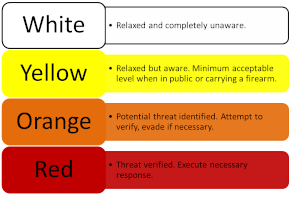Situational Awareness
Situational awareness is the knowledge of what’s going on around you. While it, in and of itself, cannot keep you safe, without it you will not know until too late whether you need to take defensive action.
The idea is to be aware of everything around you. If you know what’s there, you can make a judgement call about whether you need to worry about it. For example, you might decide not to worry about a child but a poorly dressed teen staring at you could be someone to watch. It also includes such things as checking around your car when you come up to it in a parking lot, as well as checking inside before you commit yourself to getting in. Even if you are not the victim, if you witness a crime, how much of a description could you give the police?
How much do you notice when you’re out? Here are a few fun tests with a very serious intent behind them:
- How Aware Are You? - Situational Awareness Test - #1, from VoicesOnCall
- Test Your Awareness : Whodunnit?, from dothetest
- Will You Pass the Attention Test?, from Raymond Aaron
There are many more of this type of test also.
There are also many informative discussions on Situational Awareness available. Here are a few:
- 13 ways to enhance your personal safety via situational awareness, from Arrowhead General Insurance
- 7 Ways to Improve Your Situational Awareness, from Krav Maga
- Personal Safety Tips, from UCLA Police Department
And, because you can find anything on YouTube, here are some videos that might be helpful.
- How To Improve Situational Awareness, from ARMED and Feminine
- 10 Ways to Improve Your Situational Awareness with Navy SEAL Chris Sajnog, from Chris Sajnog
Of course, you can find a lot out there. Just keep in mind that the usual caveats apply—just because it’s on the Internet does not automatically make it true or useful.
Color Coded Levels of Awareness
This is a system devised by Marine Colonel Jeff Cooper. This is an easy-to-understand series of color codes to teach awareness.

- White
- In Condition White, you are basically oblivious to your surroundings. Your mind is somewhere else, and you are a victim waiting to be attacked. This is the state most people enter when they focus on their phones or other devices in public. In this stage, you are unprepared to respond to any form of danger.
- Yellow
- In Condition Yellow, you are relaxed but aware of everyone and everything around you, paying attention to your surroundings. This is the stage you should try to stay in and should be the basis of your awareness. Being in Yellow means you can react quickly to threats if they arise, because you will not be surprised.
- Orange
- The Condition Orange stage is where you are still aware of your surroundings, just as in Yellow, but you have identified a possible threat and are on the alert. Although it may turn out to be nothing, it has caught your attention and increased your level of alertness. If the threat materializes, you will be able to respond much more quickly because you have already identified the problem and are planning solutions.
- Red
- Condition Red means you are ready to fight. You may not actually have to, but you are now prepared for the conflict. This does not mean you attack, but you are ready and waiting for a specific action by your opponent that will begin the process. This is where you have made a decision that you are ready and willing to defend yourself.
Of course, the colors are just a means of helping you to identify your situation and possible responses. For more information, here are some references:
- Cooper’s colors: A simple system for situational awareness, from Police1
- Cooper’s Colors | Levels of Awareness, audio lesson from Force Concepts
- Stay Alert: Situational Awareness Color Codes, from American Outdoor Guide
There are many more as well.
